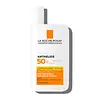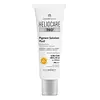What's inside
What's inside
 Key Ingredients
Key Ingredients

 Benefits
Benefits

 Concerns
Concerns

 Ingredients Side-by-side
Ingredients Side-by-side

Drometrizole Trisiloxane 7%
UV AbsorberBis-Ethylhexyloxyphenol Methoxyphenyl Triazine 5%
Skin ConditioningEthylhexyl Salicylate 5%
UV AbsorberOctocrylene 5%
UV AbsorberButyl Methoxydibenzoylmethane 3%
UV AbsorberHomosalate 2%
Skin ConditioningPhenylbenzimidazole Sulfonic Acid 0.5%
UV AbsorberWater
Skin ConditioningAlcohol Denat.
AntimicrobialSilica
AbrasiveIsopropyl Myristate
EmollientGlycerin
HumectantDiisopropyl Sebacate
EmollientC12-22 Alkyl Acrylate/Hydroxyethylacrylate Copolymer
StabilisingPropanediol
SolventPerlite
AbsorbentTocopherol
AntioxidantTriethanolamine
BufferingCaprylyl Glycol
EmollientTrisodium Ethylenediamine Disuccinate
Disodium EDTA
Hydroxyethylcellulose
Emulsion StabilisingAcrylates/C10-30 Alkyl Acrylate Crosspolymer
Emulsion StabilisingDrometrizole Trisiloxane 7%, Bis-Ethylhexyloxyphenol Methoxyphenyl Triazine 5%, Ethylhexyl Salicylate 5%, Octocrylene 5%, Butyl Methoxydibenzoylmethane 3%, Homosalate 2%, Phenylbenzimidazole Sulfonic Acid 0.5%, Water, Alcohol Denat., Silica, Isopropyl Myristate, Glycerin, Diisopropyl Sebacate, C12-22 Alkyl Acrylate/Hydroxyethylacrylate Copolymer, Propanediol, Perlite, Tocopherol, Triethanolamine, Caprylyl Glycol, Trisodium Ethylenediamine Disuccinate, Disodium EDTA, Hydroxyethylcellulose, Acrylates/C10-30 Alkyl Acrylate Crosspolymer
Water
Skin ConditioningIsododecane
EmollientCyclopentasiloxane
EmollientEthylhexyl Salicylate
UV AbsorberTrisiloxane
Skin ConditioningZinc Oxide
Cosmetic ColorantDiisopropyl Adipate
EmollientCaprylyl Methicone
Skin ConditioningTitanium Dioxide
Cosmetic ColorantNiacinamide
SmoothingDiethylhexyl Carbonate
EmollientPhenethyl Benzoate
EmollientButylene Glycol
HumectantPEG-9 Polydimethylsiloxyethyl Dimethicone
EmulsifyingTris-Biphenyl Triazine
UV AbsorberStyrene/Acrylates Copolymer
Isononyl Isononanoate
EmollientCetyl PEG/PPG-10/1 Dimethicone
EmulsifyingPolyglyceryl-3 Polydimethylsiloxyethyl Dimethicone
Skin ConditioningDiethylamino Hydroxybenzoyl Hexyl Benzoate
UV FilterBis-Ethylhexyloxyphenol Methoxyphenyl Triazine
Skin ConditioningPolymethylsilsesquioxane
Polypodium Leucotomos Leaf Extract
Skin ProtectingPunica Granatum Extract
AstringentSodium Hyaluronate
HumectantGlycerin
HumectantTrehalose
HumectantUrea
BufferingSerine
MaskingPlankton Extract
Skin ConditioningAscorbic Acid
AntioxidantCitric Acid
BufferingDisteardimonium Hectorite
StabilisingAluminum Hydroxide
EmollientStearic Acid
CleansingEthylhexyl Triazone
UV AbsorberPhenylpropanol
MaskingMagnesium Sulfate
Propylene Glycol
HumectantCaprylyl Glycol
EmollientPropanediol
SolventTocopheryl Acetate
AntioxidantPentylene Glycol
Skin ConditioningTriethoxycaprylylsilane
PEG-8
HumectantTocopherol
AntioxidantGlyceryl Polyacrylate
Algin
MaskingPullulan
Disodium Phosphate
BufferingLecithin
EmollientAscorbyl Palmitate
AntioxidantPotassium Phosphate
BufferingPropylene Carbonate
SolventDisodium EDTA
Phenoxyethanol
PreservativeParfum
MaskingLinalool
PerfumingLimonene
PerfumingCI 77492
Cosmetic ColorantCI 77491
Cosmetic ColorantCI 77499
Cosmetic ColorantWater, Isododecane, Cyclopentasiloxane, Ethylhexyl Salicylate, Trisiloxane, Zinc Oxide, Diisopropyl Adipate, Caprylyl Methicone, Titanium Dioxide, Niacinamide, Diethylhexyl Carbonate, Phenethyl Benzoate, Butylene Glycol, PEG-9 Polydimethylsiloxyethyl Dimethicone, Tris-Biphenyl Triazine, Styrene/Acrylates Copolymer, Isononyl Isononanoate, Cetyl PEG/PPG-10/1 Dimethicone, Polyglyceryl-3 Polydimethylsiloxyethyl Dimethicone, Diethylamino Hydroxybenzoyl Hexyl Benzoate, Bis-Ethylhexyloxyphenol Methoxyphenyl Triazine, Polymethylsilsesquioxane, Polypodium Leucotomos Leaf Extract, Punica Granatum Extract, Sodium Hyaluronate, Glycerin, Trehalose, Urea, Serine, Plankton Extract, Ascorbic Acid, Citric Acid, Disteardimonium Hectorite, Aluminum Hydroxide, Stearic Acid, Ethylhexyl Triazone, Phenylpropanol, Magnesium Sulfate, Propylene Glycol, Caprylyl Glycol, Propanediol, Tocopheryl Acetate, Pentylene Glycol, Triethoxycaprylylsilane, PEG-8, Tocopherol, Glyceryl Polyacrylate, Algin, Pullulan, Disodium Phosphate, Lecithin, Ascorbyl Palmitate, Potassium Phosphate, Propylene Carbonate, Disodium EDTA, Phenoxyethanol, Parfum, Linalool, Limonene, CI 77492, CI 77491, CI 77499
 Reviews
Reviews

Ingredients Explained
These ingredients are found in both products.
Ingredients higher up in an ingredient list are typically present in a larger amount.
You might know this ingredient as Tinosorb S or Bemotrizinol. It is a UV filter that covers both UVA and UVB rays.
This ingredient has two peak UV absorption peaks ( 310 and 340 nm) and is able to absorb both UV-A and UV-B rays. This ingredient works by preventing UV rays from reaching and damaging your skin.
On top of that - it is highly photostable and helps prevent the photodegration of other sunscreen ingredients such as avobenzone.
Tinosorb S is allowed in the EU, Australia, and Asia. It is close to being approved by the FDA and we'll hopefully get this ingredient in the U.S. by late 2025.
Fun fact: Tinosorb S is the most effective UV absorber at maximum concentration (measured by SPF) permitted in the EU.
This ingredient is oil-soluble, so your oil-cleansers will take this right off at night.
Learn more about Bis-Ethylhexyloxyphenol Methoxyphenyl TriazineCaprylyl Glycol is a humectant and emollient, meaning it attracts and preserves moisture.
It is a common ingredient in many products, especially those designed to hydrate skin. The primary benefits are retaining moisture, skin softening, and promoting a healthy skin barrier.
Though Caprylyl Glycol is an alcohol derived from fatty acids, it is not the kind that can dry out skin.
This ingredient is also used as a preservative to extend the life of products. It has slight antimicrobial properties.
Learn more about Caprylyl GlycolDisodium EDTA plays a role in making products more stable by aiding other preservatives.
It is a chelating agent, meaning it neutralizes metal ions that may be found in a product.
Disodium EDTA is a salt of edetic acid and is found to be safe in cosmetic ingredients.
Learn more about Disodium EDTAEthylhexyl Salicylate is an organic compound used to block UV rays. It primarily absorbs UVB rays but offers a small amount of UVA protection as well.
Commonly found in sunscreens, Ethylhexyl Salicylate is created from salicylic acid and 2-ethylhexanol. You might know salicylic acid as the effective acne fighter ingredient and BHA.
The ethylhexanol in this ingredient is a fatty alcohol and helps hydrate your skin, similar to oils. It is an emollient, which means it traps moisture into the skin.
According to manufacturers, Ethylhexyl Salicylate absorbs UV wavelength of 295-315 nm, with a peak absorption at 307-310 nm. UVA rays are linked to long term skin damage, such as hyperpigmentation. UVB rays emit more energy and are capable of damaging our DNA. UVB rays cause sunburn.
Learn more about Ethylhexyl SalicylateGlycerin is already naturally found in your skin. It helps moisturize and protect your skin.
A study from 2016 found glycerin to be more effective as a humectant than AHAs and hyaluronic acid.
As a humectant, it helps the skin stay hydrated by pulling moisture to your skin. The low molecular weight of glycerin allows it to pull moisture into the deeper layers of your skin.
Hydrated skin improves your skin barrier; Your skin barrier helps protect against irritants and bacteria.
Glycerin has also been found to have antimicrobial and antiviral properties. Due to these properties, glycerin is often used in wound and burn treatments.
In cosmetics, glycerin is usually derived from plants such as soybean or palm. However, it can also be sourced from animals, such as tallow or animal fat.
This ingredient is organic, colorless, odorless, and non-toxic.
Glycerin is the name for this ingredient in American English. British English uses Glycerol/Glycerine.
Learn more about GlycerinPropanediol is an all-star ingredient. It softens, hydrates, and smooths the skin.
It’s often used to:
Propanediol is not likely to cause sensitivity and considered safe to use. It is derived from corn or petroleum with a clear color and no scent.
Learn more about PropanediolTocopherol (also known as Vitamin E) is a common antioxidant used to help protect the skin from free-radicals and strengthen the skin barrier. It's also fat soluble - this means our skin is great at absorbing it.
Vitamin E also helps keep your natural skin lipids healthy. Your lipid skin barrier naturally consists of lipids, ceramides, and fatty acids. Vitamin E offers extra protection for your skin’s lipid barrier, keeping your skin healthy and nourished.
Another benefit is a bit of UV protection. Vitamin E helps reduce the damage caused by UVB rays. (It should not replace your sunscreen). Combining it with Vitamin C can decrease sunburned cells and hyperpigmentation after UV exposure.
You might have noticed Vitamin E + C often paired together. This is because it is great at stabilizing Vitamin C. Using the two together helps increase the effectiveness of both ingredients.
There are often claims that Vitamin E can reduce/prevent scarring, but these claims haven't been confirmed by scientific research.
Learn more about TocopherolWater. It's the most common cosmetic ingredient of all. You'll usually see it at the top of ingredient lists, meaning that it makes up the largest part of the product.
So why is it so popular? Water most often acts as a solvent - this means that it helps dissolve other ingredients into the formulation.
You'll also recognize water as that liquid we all need to stay alive. If you see this, drink a glass of water. Stay hydrated!
Learn more about Water